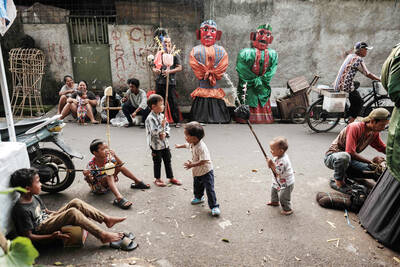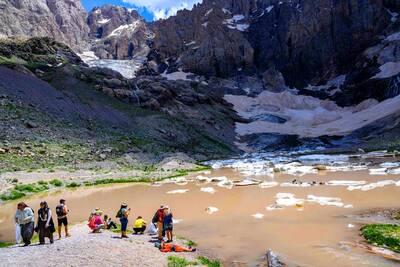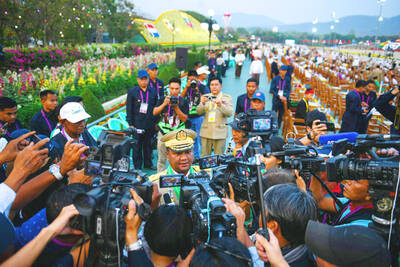Twenty years after a seismic jolt of history sent it tumbling down, a section of the Berlin Wall has been rebuilt in Los Angeles, offering residents a glimpse of the brutal Cold War frontier that once divided Europe.
Since the middle of last month, 10 towering slabs of concrete that separated East and West Berlin until Nov. 9, 1989, have been installed along Wilshire Boulevard in front of Los Angeles County Museum of Art.
The wall sections were acquired by the Los Angeles-based Wende Museum, a non-profit organization dedicated to acquiring, preserving and enabling access to Cold War-era artifacts from Eastern Europe. The 2.35 tonne slabs have been made available to artists, who have been given free rein to make their own statements on each block of concrete.
“The Wall is a blank canvas,” Wende Museum president Justinian Jampol said. “The Berlin Wall is such an international symbol. And it’s not even a wall any more. People have imposed their own ideas about what it means.”
Jampol said visitors to the wall exhibit had different interpretations of what it represented.
“You have people coming by, they don’t quite know whether they can touch it or not, if it’s historical, if it’s not, is it something we are allowed to interface with or not,” he said. “It’s amazing to see the diversity of those responses. Sometimes, it’s the Mexican-American wall, sometimes it’s the Israeli wall, sometimes, it’s a psychological wall.”
Artists who have been invited to use the wall as their canvas include Berlin-based Frenchman Thierry Noir, who was invited to help “maintain the memory” of the end of the Cold War.
Noir, a Berlin resident since 1982, has painted a large, stylized and lengthened facial profile composed of only three colors, a variation on an image he often painted on the wall in the years before its collapse.
The simplicity of the image’s design was rooted in practicality, Noir explained. Artists painting on the wall often had to work quickly in order to avoid the attention of East German border guards.
Noir recalled being harangued with the command: “Citizen of West Berlin, return immediately to your zone.”
“But in the last few months before the fall of the wall we got our revenge,” he said. “We were able to go through holes in the wall in some places and paint on the eastern side, which enraged the soldiers because they’d been told they could no longer shoot on sight.”
Los Angeles-based artist Farrah Karapetian said the exhibit had relevance to city neighborhoods divided by large multi-lane freeways: “LA has a horrible freeway system that kind of cuts through everything and make it possible to avoid certain neighborhoods if you want to ... It’s kind of a class wall.”
The Wende Museum’s “Wall Project” will culminate at midnight on Sunday, when a graffiti-strewn replica of the Berlin Wall will be erected across Wilshire Boulevard, one of Los Angels’ main east-west transport routes, before being symbolically toppled.

In the sweltering streets of Jakarta, buskers carry towering, hollow puppets and pass around a bucket for donations. Now, they fear becoming outlaws. City authorities said they would crack down on use of the sacred ondel-ondel puppets, which can stand as tall as a truck, and they are drafting legislation to remove what they view as a street nuisance. Performances featuring the puppets — originally used by Jakarta’s Betawi people to ward off evil spirits — would be allowed only at set events. The ban could leave many ondel-ondel buskers in Jakarta jobless. “I am confused and anxious. I fear getting raided or even

Kemal Ozdemir looked up at the bare peaks of Mount Cilo in Turkey’s Kurdish majority southeast. “There were glaciers 10 years ago,” he recalled under a cloudless sky. A mountain guide for 15 years, Ozdemir then turned toward the torrent carrying dozens of blocks of ice below a slope covered with grass and rocks — a sign of glacier loss being exacerbated by global warming. “You can see that there are quite a few pieces of glacier in the water right now ... the reason why the waterfalls flow lushly actually shows us how fast the ice is melting,” he said.

RISING RACISM: A Japanese group called on China to assure safety in the country, while the Chinese embassy in Tokyo urged action against a ‘surge in xenophobia’ A Japanese woman living in China was attacked and injured by a man in a subway station in Suzhou, China, Japanese media said, hours after two Chinese men were seriously injured in violence in Tokyo. The attacks on Thursday raised concern about xenophobic sentiment in China and Japan that have been blamed for assaults in both countries. It was the third attack involving Japanese living in China since last year. In the two previous cases in China, Chinese authorities have insisted they were isolated incidents. Japanese broadcaster NHK did not identify the woman injured in Suzhou by name, but, citing the Japanese

RESTRUCTURE: Myanmar’s military has ended emergency rule and announced plans for elections in December, but critics said the move aims to entrench junta control Myanmar’s military government announced on Thursday that it was ending the state of emergency declared after it seized power in 2021 and would restructure administrative bodies to prepare for the new election at the end of the year. However, the polls planned for an unspecified date in December face serious obstacles, including a civil war raging over most of the country and pledges by opponents of the military rule to derail the election because they believe it can be neither free nor fair. Under the restructuring, Myanmar’s junta chief Min Aung Hlaing is giving up two posts, but would stay at the